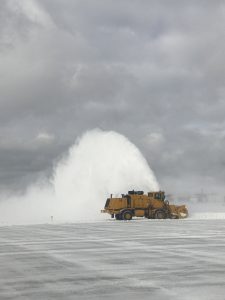While we all may be starting to wish Old Man Winter will take his leave of us soon, we still have a couple months of operating our aircraft, and Wings of Mercy trips during the colder season. This season brings with it challenges for pilots in obtaining current information about runway conditions that can be important to our decisions of what taxiways, runways, or even airports may be the best to use for some of our flights.

NOTAMs are the primary official delivery mechanism for current information such as closures of things like runways, taxiways, or even airports, but many times these are not issued for very “temporary” conditions. Which means a pilot may not be able to find critical information for flight operations through official sources. Certainly, check those NOTAMs, but in some cases, at smaller airports that may have less staffing infrastructures and official reporting practices especially, a well-placed phone call prior to a departure when any questions exist can be well worth the time.
Not all airports are all that good about getting current NOTAMs out for changing conditions. In many cases, airports are plowed, operated, and/or managed by the local municipality who has little interaction or even interest with day-to-day flight operations. Local road crews just plow the runway as a part of their normal route. Sometimes, this is right after the storm, sometimes, it can be days. Knowing what current conditions really are may mean doing a little more research than a pre-flight briefing.

Ps…did you also know that there is an App for the Michigan Airport Directory? Search it in the iTunes store and you will find the digital download app version of this.
In most cases, an airport operations, an airport manager, or an FBO contact phone number can be found in Chart Supplements, by visiting AirNav.com and reviewing the airport information, or like in the case of Michigan, by reviewing the data page published by the state in the Michigan Aeronautical Directory (also available online at: http://www.michigan.gov/aero/0,4533,7-145-61367—,00.html)
Knowing how far back snowbanks are can be important to knowing if you can taxi that multi-engine aircraft into a ramp without hitting your props. Getting a current report on how deep any snow is on the runway may let you choose if you want to land on one runway or another, and help make decisions based on this information that may determine if you choose to land in a crosswind. Finding out that the runway is ice covered before you go and find yourself sliding off a runway may allow you to instead choose an airport 20 miles away that happened to be out of a recent lake-effect snow band.
Sometimes, we get focused on our official information resources, and forget, that a simple phone call to the people “on the ground” can get us the best eyes on report of what the conditions really are going to be where we want to land. With that information, we can make even better pilot decisions.
Soon enough, this winter will again bring us to Spring and Summer flying, but until then, make a phone call if you have any questions of if the conditions you are flying toward may raise any potential risk to your safest possible operation.
